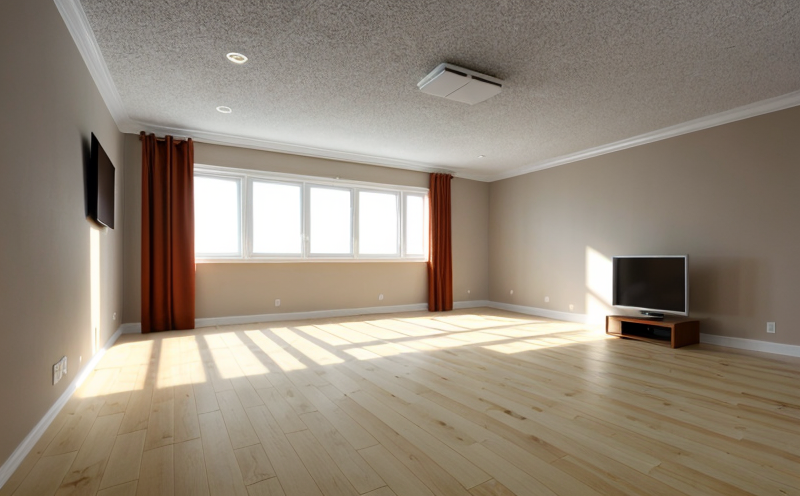ASTM E336/E336M Noise Reduction Testing of Building Elements
The ASTM E336 and E336M standards provide a comprehensive approach to evaluating noise reduction properties of building elements, such as partitions, doors, and windows. This test is crucial for ensuring that constructed buildings meet the required sound insulation levels specified by local regulations and international standards like ISO 140-4. The primary goal of this testing method is to assess how effectively a specific building element blocks out noise from one side of the barrier to another.
During ASTM E336/E336M testing, a calibrated sound source generates controlled sound levels on one side of the test specimen, while a microphone measures the resulting sound level on the opposite side. The difference between these two measurements indicates the amount of noise that passes through the element and is used to calculate its noise reduction (NR) value.
The ASTM E336/E336M procedure involves several key steps:
- Specimen Preparation: The test specimen must be installed in a sound booth with appropriate boundary conditions to ensure accurate results. This includes minimizing reflections from adjacent surfaces and ensuring that the specimen is representative of its intended use.
- Sound Generation: A broadband noise source generates controlled sound levels at various frequencies, simulating real-world environmental conditions such as speech, traffic noises, or machinery sounds.
- Measurement: Microphones placed on both sides of the specimen record sound pressure levels. The difference between these recordings provides the decibel reduction achieved by the material.
- Data Analysis: Calculations are performed to determine the NR value for each frequency band used in the test. Compliance with specified noise reduction criteria is assessed based on these values.
The results of ASTM E336/E336M testing play a significant role in ensuring compliance with building codes and standards, enhancing occupant comfort by reducing unwanted noise intrusion, and improving overall acoustic performance within the structure. By accurately quantifying the noise reduction capabilities of materials used in construction projects, these tests help architects, engineers, and builders design more effective soundproofing solutions.
ASTM E336/E336M is widely recognized for its rigorous methodology and applicability across various building types including residential homes, commercial offices, schools, hospitals, and industrial facilities. Its relevance extends beyond mere compliance; it also supports the development of innovative products that meet increasingly stringent acoustic performance requirements.
The ASTM E336/E336M standard is essential for any organization involved in architectural design, construction management, product development, or material selection where sound insulation is a critical factor. Whether you're working on new constructions or retrofitting existing buildings, understanding and adhering to this standard ensures that your projects comply with relevant regulations while delivering superior acoustic performance.
Why It Matters
The importance of ASTM E336/E336M noise reduction testing cannot be overstated. In today’s fast-paced world, people spend a significant portion of their time in enclosed spaces such as offices, classrooms, and hospitals where excessive noise can lead to stress, distraction, sleep disturbances, and even health issues. Effective noise control is therefore vital for creating comfortable environments that promote productivity, learning, healing, and overall well-being.
By conducting ASTM E336/E336M tests on building elements like partitions, doors, and windows, organizations can ensure they are meeting the specified noise reduction requirements set forth by local regulations and international standards. This not only helps avoid potential legal penalties but also enhances the reputation of both clients and contractors involved in construction projects.
The benefits extend far beyond mere compliance; they include:
- Enhanced occupant comfort through reduced noise levels,
- Better thermal insulation due to improved barrier performance,
- Increased energy efficiency by optimizing heat retention within buildings,
- Promotion of healthier workspaces and learning environments,
- Reduction in environmental impact from lower noise emissions.
In summary, ASTM E336/E336M testing is not just about meeting regulatory requirements; it’s about fostering healthier, more productive spaces for everyone involved. It contributes significantly to achieving sustainable development goals by promoting quieter and safer environments.
Benefits
The implementation of ASTM E336/E336M noise reduction testing offers numerous advantages that positively impact various stakeholders involved in the construction industry:
- Enhanced Compliance: Ensures strict adherence to relevant building codes and standards, thereby avoiding costly penalties and delays.
- Better Quality Control: Identifies potential issues early on during the manufacturing or installation process, allowing for corrective actions before they become major problems.
- Improved Reputation: Demonstrates commitment to high-quality products and services, which can enhance brand image and customer satisfaction.
- Innovation Opportunities: Encourages exploration of new materials and techniques that offer superior acoustic performance.
- Economic Savings: Reduces long-term maintenance costs by preventing damage caused by excessive noise levels over time.
- Environmental Impact Reduction: Contributes towards creating sustainable buildings with minimal adverse effects on the surrounding ecosystem.
- Healthier Workplaces: Creates safer and more comfortable working conditions for employees, leading to increased job satisfaction and productivity.
- Safer Learning Environments: Provides quieter classrooms conducive to better concentration among students and teachers alike.
In conclusion, ASTM E336/E336M noise reduction testing is more than just a compliance measure; it represents an investment in creating high-quality, sustainable structures that benefit society at large. By embracing this standard, organizations can contribute significantly to improving the overall quality of life for all occupants.





